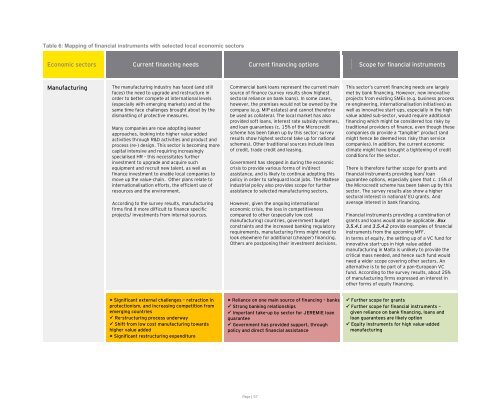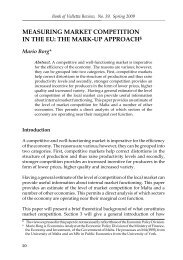Market Gaps on Access to Finance - Bank of Valletta
Market Gaps on Access to Finance - Bank of Valletta
Market Gaps on Access to Finance - Bank of Valletta
You also want an ePaper? Increase the reach of your titles
YUMPU automatically turns print PDFs into web optimized ePapers that Google loves.
Table 6: Mapping <strong>of</strong> financial instruments with selected local ec<strong>on</strong>omic sec<strong>to</strong>rs<br />
Ec<strong>on</strong>omic sec<strong>to</strong>rs Current financing needs Current financing opti<strong>on</strong>s Scope for financial instruments<br />
Manufacturing<br />
The manufacturing industry has faced (and still<br />
faces) the need <strong>to</strong> upgrade and restructure in<br />
order <strong>to</strong> better compete at internati<strong>on</strong>al levels<br />
(especially with emerging markets) and at the<br />
same time face challenges brought about by the<br />
dismantling <strong>of</strong> protective measures.<br />
Many companies are now adopting leaner<br />
approaches, looking in<strong>to</strong> higher value-added<br />
activities through R&D activities and product and<br />
process (re-) design. This sec<strong>to</strong>r is becoming more<br />
capital intensive and requiring increasingly<br />
specialised HR – this necessitates further<br />
investment <strong>to</strong> upgrade and acquire such<br />
equipment and recruit new talent, as well as<br />
finance investment <strong>to</strong> enable local companies <strong>to</strong><br />
move up the value-chain. Other plans relate <strong>to</strong><br />
internati<strong>on</strong>alisati<strong>on</strong> efforts, the efficient use <strong>of</strong><br />
resources and the envir<strong>on</strong>ment.<br />
According <strong>to</strong> the survey results, manufacturing<br />
firms find it more difficult <strong>to</strong> finance specific<br />
projects/ investments from internal sources.<br />
Significant external challenges – retracti<strong>on</strong> in<br />
protecti<strong>on</strong>ism, and increasing competiti<strong>on</strong> from<br />
emerging countries<br />
Re-structuring process underway<br />
Shift from low cost manufacturing <strong>to</strong>wards<br />
higher value added<br />
Significant restructuring expenditure<br />
Commercial bank loans represent the current main<br />
source <strong>of</strong> finance (survey results show highest<br />
sec<strong>to</strong>ral reliance <strong>on</strong> bank loans). In some cases,<br />
however, the premises would not be owned by the<br />
company (e.g. MIP estates) and cannot therefore<br />
be used as collateral. The local market has also<br />
provided s<strong>of</strong>t loans, interest rate subsidy schemes,<br />
and loan guarantees (c. 15% <strong>of</strong> the Microcredit<br />
scheme has been taken up by this sec<strong>to</strong>r; survey<br />
results show highest sec<strong>to</strong>ral take up for nati<strong>on</strong>al<br />
schemes). Other traditi<strong>on</strong>al sources include lines<br />
<strong>of</strong> credit, trade credit and leasing.<br />
Government has stepped in during the ec<strong>on</strong>omic<br />
crisis <strong>to</strong> provide various forms <strong>of</strong> in/direct<br />
assistance, and is likely <strong>to</strong> c<strong>on</strong>tinue adopting this<br />
policy in order <strong>to</strong> safeguard local jobs. The Maltese<br />
industrial policy also provides scope for further<br />
assistance <strong>to</strong> selected manufacturing sec<strong>to</strong>rs.<br />
However, given the <strong>on</strong>going internati<strong>on</strong>al<br />
ec<strong>on</strong>omic crisis, the loss in competitiveness<br />
compared <strong>to</strong> other (especially low cost<br />
manufacturing) countries, government budget<br />
c<strong>on</strong>straints and the increased banking regula<strong>to</strong>ry<br />
requirements, manufacturing firms might need <strong>to</strong><br />
look elsewhere for additi<strong>on</strong>al (cheaper) financing.<br />
Others are postp<strong>on</strong>ing their investment decisi<strong>on</strong>s.<br />
Reliance <strong>on</strong> <strong>on</strong>e main source <strong>of</strong> financing – banks<br />
Str<strong>on</strong>g banking relati<strong>on</strong>ships<br />
Important take-up by sec<strong>to</strong>r for JEREMIE loan<br />
guarantee<br />
Government has provided support, through<br />
policy and direct financial assistance<br />
Page | 57<br />
This sec<strong>to</strong>r’s current financing needs are largely<br />
met by bank financing. However, new innovative<br />
projects from existing SMEs (e.g. business process<br />
re-engineering, internati<strong>on</strong>alisati<strong>on</strong> initiatives) as<br />
well as innovative start-ups, especially in the high<br />
value added sub-sec<strong>to</strong>r, would require additi<strong>on</strong>al<br />
financing which might be c<strong>on</strong>sidered <strong>to</strong>o risky by<br />
traditi<strong>on</strong>al providers <strong>of</strong> finance, even though these<br />
companies do provide a “tangible” product (and<br />
might hence be deemed less risky than service<br />
companies). In additi<strong>on</strong>, the current ec<strong>on</strong>omic<br />
climate might have brought a tightening <strong>of</strong> credit<br />
c<strong>on</strong>diti<strong>on</strong>s for the sec<strong>to</strong>r.<br />
There is therefore further scope for grants and<br />
financial instruments providing loan/ loan<br />
guarantee opti<strong>on</strong>s, especially given that c. 15% <strong>of</strong><br />
the Microcredit scheme has been taken up by this<br />
sec<strong>to</strong>r. The survey results also show a higher<br />
sec<strong>to</strong>ral interest in nati<strong>on</strong>al/ EU grants. And<br />
average interest in bank financing.<br />
Financial instruments providing a combinati<strong>on</strong> <strong>of</strong><br />
grants and loans would also be applicable. Box<br />
3.5.4.1 and 3.5.4.2 provide examples <strong>of</strong> financial<br />
instruments from the upcoming MFF.<br />
In terms <strong>of</strong> equity, the setting up <strong>of</strong> a VC fund for<br />
innovative start-ups in high value added<br />
manufacturing in Malta is unlikely <strong>to</strong> provide the<br />
critical mass needed, and hence such fund would<br />
need a wider scope covering other sec<strong>to</strong>rs. An<br />
alternative is <strong>to</strong> be part <strong>of</strong> a pan-European VC<br />
fund. According <strong>to</strong> the survey results, about 25%<br />
<strong>of</strong> manufacturing firms expressed an interest in<br />
other forms <strong>of</strong> equity financing.<br />
Further scope for grants<br />
Further scope for financial instruments –<br />
given reliance <strong>on</strong> bank financing, loans and<br />
loan guarantees are likely opti<strong>on</strong><br />
Equity instruments for high value-added<br />
manufacturing







